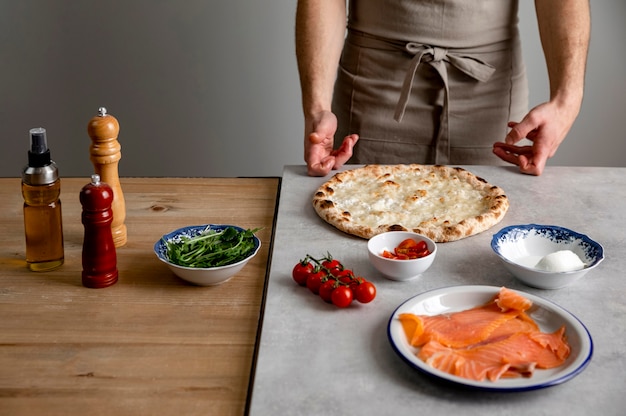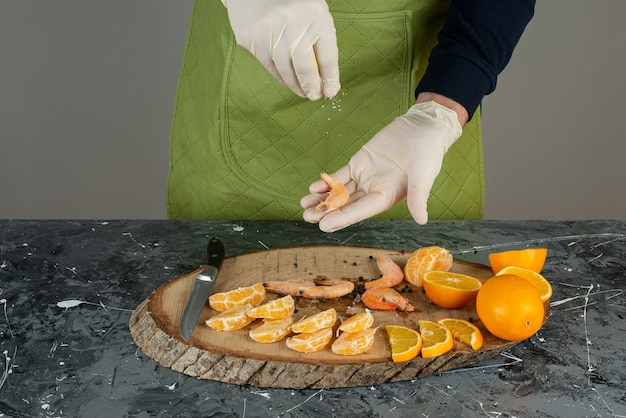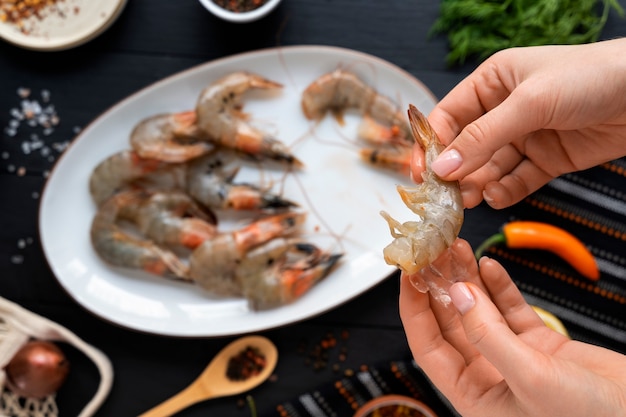There's something undeniably luxurious about a plate of perfectly cooked lobster tail. The sweet, delicate flavour, the tender, juicy flesh - it's a true culinary treat. But achieving that restaurant-quality experience at home can feel a bit daunting, especially if you're not a seasoned seafood chef. Fear not, my fellow foodie, because I'm here to demystify the art of lobster tail cooking and guide you through the entire process, step by step.
Over the years, I've learned a few tricks of the trade - some from my own culinary mishaps (yes, I've definitely had a few rubbery lobster tales!), and others from seasoned chefs and culinary experts. This guide is packed with tips, techniques, and even some sneaky flavour hacks to ensure you consistently create a lobster dish that's sure to impress, whether you're whipping up a romantic dinner for two or a celebratory feast for friends.
Part 1: Choosing the Right Lobster Tail

Just like any good recipe, the key to a delicious lobster dish starts with choosing the right ingredients. A good lobster tail is the foundation of a successful meal, and knowing how to pick a fresh, high-quality one is crucial.
The Importance of Freshness
Freshness is key when it comes to lobster. A fresh lobster tail will have a vibrant, glossy shell and a firm, springy texture. The tell-tale sign of a lobster that's past its prime? A dull, faded shell and a slightly soft texture. You'll also want to check the smell - fresh lobster has a distinct, briny aroma.
Spotting the Signs of Quality
Here's what to look for when inspecting a lobster tail at the fishmonger:
- Colour: The shell should be a vibrant blue, green, or even a reddish hue. Avoid tails with dull, faded colours, as these might be older and not as fresh.
- Firmness: Give the tail a gentle squeeze. It should feel firm and springy, not soft or mushy.
- Smell: Fresh lobster has a fresh, briny smell. If you detect any off odours, it's best to choose another one.
- Size: The size of the lobster tail will depend on how many you're cooking and your personal preference. But a good rule of thumb is to choose tails that are at least 6-8 ounces each.
frozen lobster tails: A Convenient Alternative
While fresh lobster is always the ideal choice, frozen lobster tails can be a convenient option, especially if fresh lobster isn't readily available. Just make sure to choose frozen tails from a reputable source, and always defrost them thoroughly before cooking. The thawing process should be done slowly in the refrigerator, ensuring the lobster defrosts evenly and retains its moisture.
Part 2: Prepping the Lobster

Now that you've chosen your lobster tail, it's time to prepare it for cooking. This step might seem a bit daunting, but with a few simple tools and a bit of patience, you'll be a lobster prep pro in no time.
Cleaning and Removing the Intestines
Before you get started, give the lobster tail a good rinse under cold water to remove any debris. Next, you'll need to remove the dark, vein-like intestine that runs along the underside of the tail. This is called the "vein" and is a bit of a culinary no-no.
Using a sharp knife, carefully cut a thin line down the length of the intestine and gently pull it out. Don't worry if it doesn't come out all in one piece - just keep pulling until it's removed. If you're using a frozen lobster tail, the vein will likely be more readily visible.
Butterflying for Even Cooking
Here's where the magic happens - butterflying the lobster tail. This technique allows for even cooking and helps the lobster absorb more flavour. Find the seam running along the back of the tail, and use a sharp knife to carefully cut through it, about two-thirds of the way down. Now, gently open the tail like a book, ensuring the cut goes all the way through to the tail's base.
Seasoning for Maximum Flavour
With the lobster prepped and ready to go, it's time to give it a flavour boost. Season generously with salt and pepper, and don't be afraid to get creative with other spices. Garlic powder, paprika, cayenne pepper, or even a blend of herbs can add depth and complexity to your dish.
A little tip: To maximize flavour, rub the seasonings into the flesh, ensuring the spices make good contact with the meat. You can also add a splash of lemon juice to brighten up the flavour profile.
Part 3: The Art of Cooking

You're almost there! Now comes the exciting part – actually cooking the lobster tail. There are several methods to choose from, each with its unique flavour and texture profile.
Grilling: For a Smoky, Charred Flavour
For a smoky, charred flavour, grilling is a fantastic option. It's a bit more involved than some other methods, but the results are worth it.
Getting Ready
- Preheat: Preheat your grill to medium-high heat. Make sure it's nice and hot - you want a good sear on your lobster.
- Oil Up: Brush the grill grates with a little bit of olive oil to prevent sticking. This will also help create those beautiful grill marks.
cooking time
- Grill Time: Place the lobster tails on the grill, flesh-side down. Cook for about 4-6 minutes per side, or until the flesh is opaque and firm to the touch.
- Don't Overcook: The key is to cook the lobster through without drying it out. Keep a close eye on it. The flesh should be white and opaque, but not dry or rubbery.
- Resting Time: Remove the lobster from the grill and let it rest for a few minutes before serving. This will allow the juices to redistribute and ensure the flesh remains moist.
Baking: A Classic Approach for Tenderness
Baking is a classic method for lobster, offering a simple and reliable way to cook a tender, succulent lobster tail.
Getting Ready
- Oven Preheat: Preheat your oven to 400°F (200°C).
- Butter Up: Place the lobster tails in a baking dish and drizzle them with melted butter. The butter will help to keep the lobster moist and add a rich flavour.
- Seasoning: Season the lobster tails with salt, pepper, and any other spices you like. You can experiment with different flavour combinations to find your favourite.
Cooking Time
- Bake Time: Bake the lobster tails for 10-12 minutes, or until the flesh is opaque and firm to the touch.
- Don't Overcook: Remember, lobster can overcook quickly, so keep an eye on it. You don't want it to become dry or rubbery.
- Resting Time: Remove the lobster tails from the oven and let them rest for a few minutes before serving. This helps the flesh retain moisture.
Steaming: A Gentle Approach for Delicate Flavour
For a more delicate approach that retains the lobster's natural juices and flavour, steaming is a fantastic option.
Getting Ready
- Water Boiling: Fill a large pot with about 2 inches of water. Bring it to a rolling boil.
- Steaming Basket: Place a steaming basket in the pot. Make sure the basket is large enough to accommodate your lobster tails without overcrowding.
- Lobster Placement: Carefully place the lobster tails in the steaming basket.
- Seasoning: Add a few herbs or spices to the water for added flavour. Bay leaves, thyme, or lemon slices are all great options.
Cooking Time
- Steam Time: Cover the pot and steam the lobster tails for 8-10 minutes, or until the flesh is opaque and firm to the touch.
- Don't Overcook: Steaming can sometimes be tricky, so keep a close eye on the lobster tails.
- Resting Time: Once the lobster is cooked, remove it from the steamer and let it rest for a few minutes before serving. This allows the juices to redistribute.
Part 4: Enhancing the Flavour
Now that you've got the basic cooking techniques down, let's talk about taking your lobster dish to the next level with flavour enhancements.
Garlic Butter: A Classic Pairing
Lobster and garlic butter are a match made in culinary heaven. The creamy, garlicky flavour complements the sweetness of the lobster beautifully, creating a truly indulgent experience.
Making the Garlic Butter
- Melting Time: Melt some butter in a saucepan over low heat. Use unsalted butter for a more controlled flavour.
- Garlic Infusion: Add minced garlic to the melted butter and cook until fragrant, about 1 minute. Don't overcook the garlic, as it can become bitter.
- Seasoning: Season the garlic butter with salt and pepper to taste.
- Basting: Baste the lobster tails with the garlic butter during the last few minutes of cooking. This will infuse the lobster with a delicious garlicky flavour.
Lemon and Herbs: A Bright and Aromatic Touch
For a brighter, more refreshing flavour, try adding lemon and fresh herbs. The citrus acidity cuts through the richness of the lobster, while the fresh herbs add a layer of aromatic complexity.
Adding Citrus and Herbs
- Lemon Zest: Zest a lemon over the lobster tails before cooking. The zest will add a bright, fragrant flavour.
- Lemon Juice: Squeeze some fresh lemon juice over the lobster after cooking. The acidity will brighten up the flavour.
- Herbs Galore: Use fresh herbs like parsley, chives, or dill to garnish the lobster. These herbs will add a burst of freshness and colour to your dish.
Part 5: Serving Up Your Masterpiece
The moment of truth! You've chosen, prepped, and cooked the perfect lobster tail. Now it's time to present it with style and enjoy the fruits of your labour.
Presentation Tips
Presentation is an integral part of any culinary experience. A beautifully presented lobster dish can elevate the dining experience and impress your guests.
- Serving Plates: Use elegant serving plates to enhance the visual appeal.
- Garnishing: Add a touch of colour and flavour with fresh herbs, lemon wedges, or a drizzle of olive oil.
- side dishes: Choose side dishes that complement the lobster, such as roasted vegetables, creamy risotto, or a simple salad.
Part 6: Cracking the Code: Lobster Tail Techniques
You've prepared a delicious lobster tail, but now comes the fun part - cracking it open and enjoying the succulent meat. Don't worry, it's easier than you think!
Lobster Cracking Tools
You'll need a lobster cracker, a tool specifically designed for cracking lobster shells. These are available at most kitchen stores.
Cracking Techniques
- The Crack: Place the lobster tail on a cutting board and use the lobster cracker to crack the shell open. You'll want to crack it along the seam down the back.
- The Fork: Once the shell is cracked open, use a fork to extract the delicious meat. You can also use a lobster picker or a small, sharp knife to help you remove the meat.
Tips for Extracting the Meat
- The Tail: If you're struggling to extract the meat from the tail, try gently twisting the tail to separate the flesh from the shell.
- The Claws: If you've got a whole lobster, you'll need to crack the claws open. Use a nutcracker or a sturdy kitchen knife to crack the claw.
- The Meat: The meat should come out easily once the shell is cracked.
Part 7: lobster tail recipes
Now that you've got the basics down, it's time to unleash your inner culinary creativity. Here are a few recipes to get you started:
Garlic Herb Lobster Tail
Ingredients
- 2 lobster tails
- 2 tablespoons melted butter
- 2 cloves garlic, minced
- 1 teaspoon chopped fresh parsley
- 1/2 teaspoon chopped fresh thyme
- Salt and pepper to taste
Instructions
- Preheat oven to 400°F (200°C).
- Butterfly the lobster tails.
- In a small bowl, combine the melted butter, garlic, parsley, and thyme. Season with salt and pepper.
- Brush the lobster tails with the garlic butter mixture.
- Place the lobster tails on a baking sheet and bake for 10-12 minutes, or until the flesh is opaque and firm to the touch.
- Serve immediately.
Lemon Butter Lobster Tail
Ingredients
- 2 lobster tails
- 2 tablespoons melted butter
- 1 tablespoon lemon juice
- 1 teaspoon grated lemon zest
- Salt and pepper to taste
Instructions
- Preheat oven to 400°F (200°C).
- Butterfly the lobster tails.
- In a small bowl, combine the melted butter, lemon juice, and lemon zest. Season with salt and pepper.
- Brush the lobster tails with the lemon butter mixture.
- Place the lobster tails on a baking sheet and bake for 10-12 minutes, or until the flesh is opaque and firm to the touch.
- Serve immediately.
grilled lobster Tail with Chili Butter
Ingredients
- 2 lobster tails
- 2 tablespoons melted butter
- 1 tablespoon chili flakes
- 1 clove garlic, minced
- Salt and pepper to taste
Instructions
- Preheat grill to medium-high heat.
- Butterfly the lobster tails.
- In a small bowl, combine the melted butter, chili flakes, and garlic. Season with salt and pepper.
- Brush the lobster tails with the chili butter mixture.
- Place the lobster tails on the grill, flesh-side down. Cook for 4-6 minutes per side, or until the flesh is opaque and firm to the touch.
- Serve immediately.
Part 8: Lobster Tail Side Dishes
No delicious lobster tail meal is complete without a perfect side dish to complement its flavour and texture.
Side Dish Ideas
- Roasted Vegetables: roasted asparagus, broccoli, or Brussels sprouts are a perfect pairing for the rich flavour of lobster. The roasted vegetables add a touch of sweetness and a satisfying crunch.
- Creamy Risotto: A creamy risotto, such as mushroom risotto or asparagus risotto, provides a luxurious contrast to the lobster. The creamy texture and earthy flavours complement the lobster beautifully.
- Simple Salad: A fresh salad with a light vinaigrette will cleanse the palate and provide a refreshing counterpoint to the lobster. Choose greens like arugula, spinach, or romaine lettuce, and add seasonal vegetables like tomatoes, cucumbers, or bell peppers.
- potato salad: A classic potato salad is a hearty and comforting side dish that complements the lobster well. You can use a creamy dressing or a tangy vinegar-based dressing, depending on your preference.
- corn on the cob: Grilled or roasted corn on the cob is a summery side dish that complements the lobster perfectly. The sweetness of the corn balances the richness of the lobster.
Part 9: FAQs
Let's address some common questions about cooking lobster tails.
- How do I know when my lobster tail is cooked? The flesh should be opaque and firm to the touch. You can also test it with a fork – the meat should be firm and not flakey.
- What happens if I overcook my lobster tail? Overcooked lobster tail becomes rubbery and dry. The meat will be tough and lose its succulent texture.
- Can I freeze lobster tails? Yes, you can freeze lobster tails. To freeze, wrap the lobster tails tightly in plastic wrap and then place them in a freezer bag. They can be frozen for up to 3 months.
- How long should I defrost frozen lobster tails? You can defrost lobster tails in the refrigerator overnight. You can also defrost them in a bowl of cold water, which will take about 30 minutes.
- What are some good substitutes for lobster tails? If you can't find lobster tails, you can use other types of shellfish, such as crab legs, shrimp, or scallops. These alternatives offer a similar flavour profile and texture, but remember to adjust the cooking times accordingly.
So there you have it, a complete guide to cooking the perfect lobster tail. Armed with these tips, techniques, and recipes, you're ready to impress yourself and your guests with a delicious lobster dish that's sure to become a favourite. Now go forth, experiment, and enjoy the succulent, sweet taste of lobster!
Everyone is watching

Corn on the Cob: The Ultimate Guide to Perfectly Cooked Ears
Healthy MealsAh, corn on the cob. Just the name evokes images of sunny days, barbecues, and that sweet, juicy flavour that ...

Perfect Pork Roast Oven Cooking Time: A Guide to Delicious Results
Healthy MealsThere's something truly satisfying about a perfectly roasted pork. The aroma alone is enough to make your mout...

Scallops: The Ultimate Guide to Perfect Cooking
Healthy MealsAh, scallops. Those delicate, sweet, and utterly delicious morsels of the sea. They hold a special place in my...

Ham Cooking Time: How Long to Bake, Smoke, or Boil a Delicious Ham
Healthy MealsAh, ham. It's a classic, isn't it? A real crowd-pleaser, especially around holidays. And when done right, it'...

Spaghetti Squash: The Ultimate Guide to Cooking and Serving
Healthy MealsRemember that time you saw spaghetti squash at the supermarket, looking all bumpy and strange, and thought, "W...
